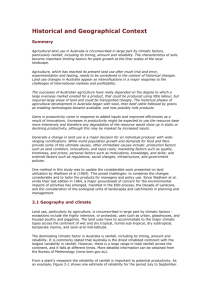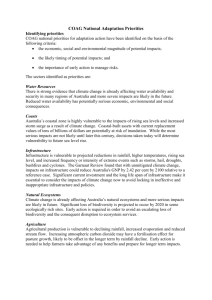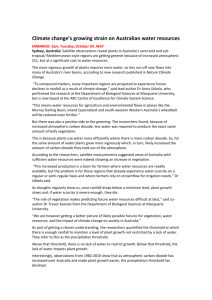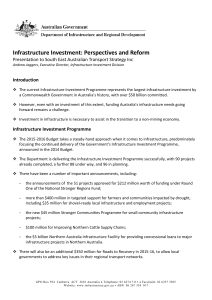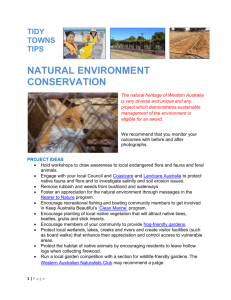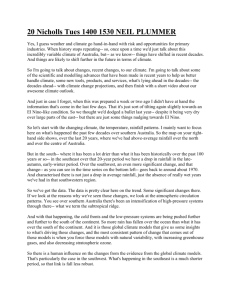DOCX
advertisement
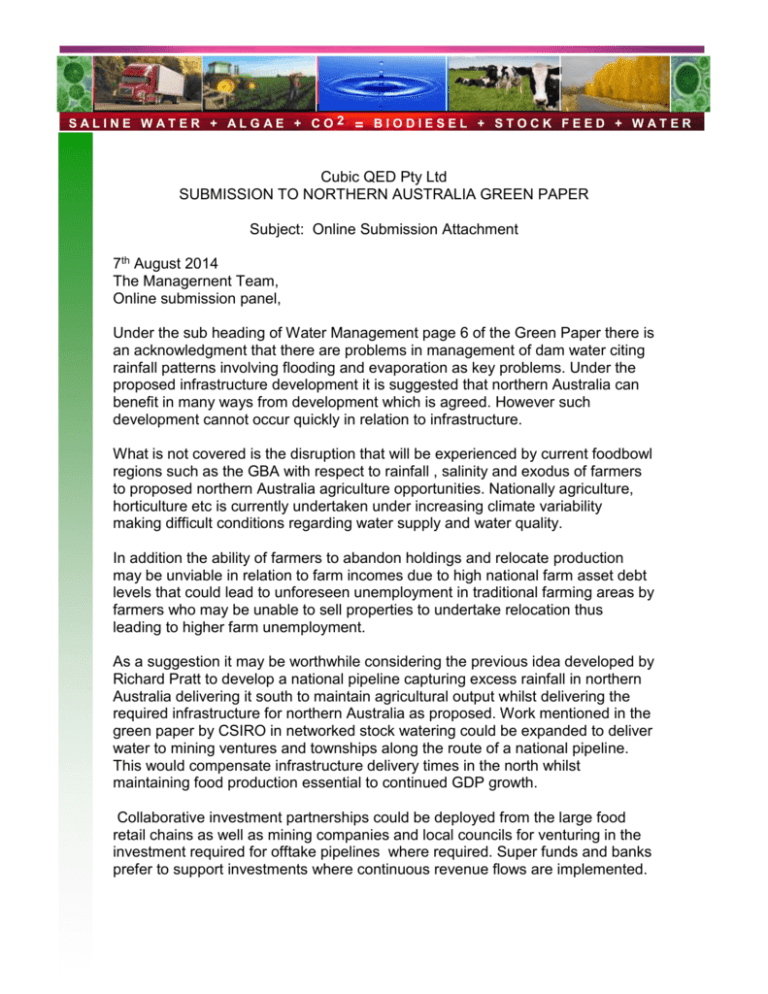
SALINE WATER + ALGAE + CO 2 = BIODIESEL + STOCK FEED + WATER Cubic QED Pty Ltd SUBMISSION TO NORTHERN AUSTRALIA GREEN PAPER Subject: Online Submission Attachment 7th August 2014 The Managernent Team, Online submission panel, Under the sub heading of Water Management page 6 of the Green Paper there is an acknowledgment that there are problems in management of dam water citing rainfall patterns involving flooding and evaporation as key problems. Under the proposed infrastructure development it is suggested that northern Australia can benefit in many ways from development which is agreed. However such development cannot occur quickly in relation to infrastructure. What is not covered is the disruption that will be experienced by current foodbowl regions such as the GBA with respect to rainfall , salinity and exodus of farmers to proposed northern Australia agriculture opportunities. Nationally agriculture, horticulture etc is currently undertaken under increasing climate variability making difficult conditions regarding water supply and water quality. In addition the ability of farmers to abandon holdings and relocate production may be unviable in relation to farm incomes due to high national farm asset debt levels that could lead to unforeseen unemployment in traditional farming areas by farmers who may be unable to sell properties to undertake relocation thus leading to higher farm unemployment. As a suggestion it may be worthwhile considering the previous idea developed by Richard Pratt to develop a national pipeline capturing excess rainfall in northern Australia delivering it south to maintain agricultural output whilst delivering the required infrastructure for northern Australia as proposed. Work mentioned in the green paper by CSIRO in networked stock watering could be expanded to deliver water to mining ventures and townships along the route of a national pipeline. This would compensate infrastructure delivery times in the north whilst maintaining food production essential to continued GDP growth. Collaborative investment partnerships could be deployed from the large food retail chains as well as mining companies and local councils for venturing in the investment required for offtake pipelines where required. Super funds and banks prefer to support investments where continuous revenue flows are implemented. In this case a national pipeline offers opportunities to adopt new models for water delivery infrastructure from sale of high quality water. As mentioned evaporation rates of dams in the north is a particular problem as is seasonal rainfall highs that cause flooding and seasonal dry periods where water may be in short supply. What might be achieved is a balancing of the seasonal flows of water. An additional problem is the mineral level in water from both fertilizers and naturally occurring salts. Water technologies in recent two years have undergone robust technology development and have already demonstrated the ability to remove unwanted salts/ minerals such as high iron levels from both mine water and groundwater by new separation processes at much cheaper cost than reverse osmosis in brackish water environments. Deployment of new water purification technology could be facilitated along the route delivering potable water. In addition the huge volume of water that is lost to runoff in the north may be recovered for supporting river flows to the southern states of Victoria New South Wales and South Australia as part of a national water pipeline infrastructure. The original Pratt scheme from memory was costed under preliminary feasibility at $10 billion in 2002. The ANZ Bank recently announced that an investment of $600 billion was required by 2050 for upgrading Australia's agricultural infrastructure to sustain production and develop exports to Asia markets. Even if Pratt scheme was to triple it would be within the projected investment target as a small percentage of total infrastructure investment. Supermarket retailers in food may embrace such development as a means of securing long term commercial advantage via equity in a water pipeline that supports growers on which their business models are reliant. Similarly mining companies may experience benefits from equity in such infrastructure. The upside may be the ability to diversify investment base for the projected lucrative export markets to Asia as would the food retailers as commented by Richard Goyder and Andrew Forrest in the media recently. It was noted that the previous Howard Government did not support a full feasibility for such a proposal. However the Ord Irrigation Scheme was developed under Liberal Government under the leadership of Robert Menzies as the most exciting infrastructure investment of its day. The current Liberal Government seems to be revisiting traditional concepts developed half a century ago with potential for revitalizing under better capital management concepts multiple opportunities for a stronger economy. We support such initiatives and at the same time recommend that employment, agricultural production and investment targets proposed in the Green Paper do not overlook the potential for distortion in infrastructure expenditure that could potentially disrupt established output in the agri sector. Regards David McMurran Cubic QED Pty Ltd T: xxxxxxxxxxxx M: xxxxxxxxxxxx E: xxxxxxxxxxxx CUBIC QUOD ERAT DEMONSTRANDUM CUBICQED PTY LTD PO Box 245 Cherrybrook NSW Australia 2126 Email: i n f o @ b r i n e m a g . c o m Tel: (02) 9875 5214 ABN 111 943 036




